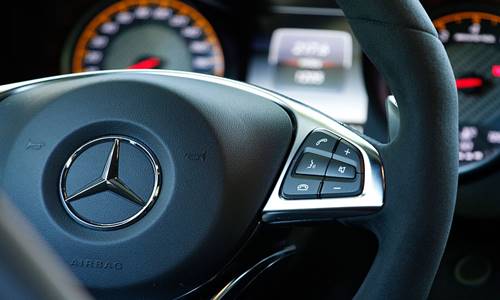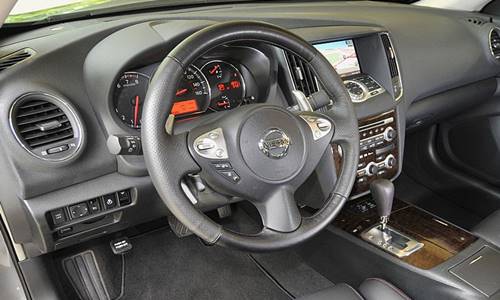
What is Paddle Shifter?
Paddle shifters are an exotic alternative solution for special cars. Where manual cars use a conventional gear stick for changing gear while driving, paddle shifters are an innovative way of putting the car into gear. Paddle shifters are present on the back of the steering wheel. By pushing them, the car gets into the driving gear, and you are great to go. They give you far better control of the engine and transmission. For an everyday driver, they bring ease and joy in driving and provide more comfortable control over there vehicle’s functioning.
How do Paddle Shifters Work?
Cars with paddle shifters have an entirely different steering wheel. Each paddle on either side is attached to the shifting lever (right for upshift and left for downshift). The dashboard will display the corresponding number of gear that you have shifted into. Once the paddle is pushed, pneumatics and actuators put the car into a higher or lower gear.
How to Use Paddle Shifters?
Operating paddle shifters is a piece of cake. Driving cars with paddle shifters is a lot easier than a car without them. On either side of the steering wheel, each one is attached, which helps you switch between 5-7 gears (depending on your car). TO begin the drive, set the level shift in D(drive); if you pull one of the paddles while driving, the transmission shifts to manual. To continue in manual, shift into M. The right paddle (plus) will help you upshift into a higher gear, whereas the left minus paddle will downshift the gear. With paddle shifters make your drive smooth and easy.
Some Common Mistakes while Driving
Some drivers change gear too early, in this case, the action is blocked. If both the paddles are pressed together simultaneously, the same happens. Make sure to hit the paddle when an electric signal is received by transmission to change the gear; this keeps the drive smooth and prevents and damage to the vehicle.
How to Drive with Paddle Shifters?
Paddle shifters do not only look super cool, but they are becoming more and more popular because of their functionality and how they give more control on the engine of the vehicle. Driving with paddle shifters is quite easy. There are two paddles at the back of each side of the steering wheel with plus and minus signs for upshifting and downshifting, respectively. Just push the paddle once you get the signal from the transmission. If you are new at this, just shift gear between 15000-20000RPM.
How to Install Paddle Shifters?

Car modification is not anything new. It might not be that easy, but a paddle shifters kit is very easy to install. Use the following steps to begin installing your very own set of shifters in your car.
- Installing Paddle Shifters Honda
For this, you will have to take the steering wheel off from the dashboard and unscrew the screws to remove the bottom cover of the steering wheel. Next, take out the paddle shifter from the holder. Then, removes the screws from it and install the paddle shifter in the wheel. Make sure the connector is connected securely. Attach the cover of the wheel and install it back on the dashboard.
- Installing Paddle Shifters BMW
To install paddle shifters in BMW, shift the car in P(park) and straighten the wheel. Make sure to disconnect the negative terminal of the battery attached to the steering wheel. And remove the airbags. Now remove the wheel and take off its cover. Install the paddles and make sure they are in the right place secured with the connector, wiring is in its place, and auto coordination is not messed up. Put back all the parts and install the steering wheel back in.
What is Steering Wheel Paddle Shifters?
These are simple paddles operated by hand, which is placed behind the steering wheel (each on either side of it). In simple words, they are present along with the turning indicators and headlight controls are there. The one present of the left has a minus (-) on it, which is for downshifting, whereas the right one with a plus (+) of it is for an upshift. You will find them mostly in sports cars; they make gear shifting more convenient and faster; synching the engine speed with gear shifting provides more power, which is what makes it idle for racing cars. Paddle shifter technology originated from F1 (Formula 1) cars, but now they are available in a lot of cars, even in non-sports cars.
What is a Slap Shift?
Slap shift is an alternative method for shifting an automatic transmission mostly used for sports cars. Officially known as the rachet shifter it is quite fun to change gear with a slap shift. To upshift, the lever is moved forward and retreats it for downshifting. There is a bit more work to do in slap shift than an automatic transmission as you have to hold the clutch and move the lever frequently, but it gives the driver more control on speed and grip, which makes it ideal for sports cars and racing cars.
List of Cars with Paddle Shifters
Here we have a list of most used cars that have paddle shifters:
- Alfa Romeo 4C (2016)
- Mitsubishi Evolution MR (2015)
- Nissan GT-R Nismo (2016)
- BMW M3 (2016)
- Dodge Charger SRT Hellcat (2016)
- Chevrolet Camaro ZL1 (2017)
- Volkswagen Golf R (2016)
- Subaru WRX (2016)
- Porsche 911 GT3 (2016)
- Jaguar F-TYPE R Coupe (2016)
Most Buying Paddle Shifter Kits
Position | Preview | Name | Price |
1. | Steering Wheel Shift Paddle Extended Shifter | ||
2. | BMW Aluminum Metal Steering Wheel Paddle Shifter | ||
3. | HIGH FLYING DSG Steering Wheel Shift Paddles Shifters Replacement Kit | ||
4. | DSG Steering Wheel Shift Paddles Shifters Replacement Kit | ||
5. | Steering Wheel Paddle Shifter Extensions For Audi |
What is a Flappy Paddle Gearbox?
Flappy paddle gearbox is different from any traditional gearbox you will see. It is somewhat similar to a manual gearbox. The difference is that in the place of a conventional gear stick, it is comprised of motors and actuators to interconnect and gear. In this case, one uses paddles to shift up or down the gear, not the stick. It is rather handy, especially for racing cars, as it enables a faster gear shift, which is coordinated with the engine speed for max speed and power.
What is a Gear Shift and Automatic Gear Shift?
Automatics Gear Shift is a hydraulic operating system that provides power to the tires from the engine to move them. A manual gear shift is when you have to press clutch now and again to upshift/downshift gear to control the speed of the car, whereas, in the automatic transmission, there is an electro-hydraulic system. There are three modes of auto gear shift in general, i.e., reverse (R), drive (D), and neutral (N). However, you may also find a P (park) and an L (low drive gear) in most advanced cars.
Do Automatic Cars Have a Clutch?
Clutch is a word usually associated with a manual car. However, this is not the case. Automatic cars also have a similar function, but the execution is a bit different. Several parts are connected to a torque converter system. This system connects the engine and transmission at the bell housing. The torque converter system works similarly to a clutch in a manual car; it is comprised of a stator, an impeller, and a lock-up-clutch.
When to Use 1st and 2nd Gear in Automatic?
In an automatic car, L, 1st, and 2nd gears are used to stay in a low shift. As these gears keep the vehicle more stable and allow tires to grip better onto the road, they are used mostly when you are driving on a slanting surface like mountainous driving or hilly areas. Make use of engine brakes when going downhill to avoid losing control. If you are driving up, keep your car in 1st then 2nd gear as they have more power.
What is a Semi-Automatic Transmission?
Usually, there are two types of cars, manual and automatic. However, there is a third type, which is an innovative mix of both known as a semi-automatic transmission. As the name shows, this type of transmission provides manual and automatic transmission functions. It has a system similar to a manual gearbox, but there is no clutch. These transmissions use actuators instead of wires and pipes. The advantage of a semi-automatic transmission is that it provides way better fuel efficiency (close to manual transmission) with ease of using an auto gearbox.
When to Shift Gears?
A rule of thumb for an experienced driver is to shift with the sound of the engine or whenever it ‘feels right’ but if you are new to this, not to worry. There is a gauge on the dashboard called a tachometer, which displays the number of the revolution/min of the engine’s crankshaft. Notice the RPM. When it is between 15,000-20,000, that is when you shift up. If you hear the engine making rumbling noises, you need to shift down the gear. Similarly, if you hear screeching and squeaking, shift up.
How to Downshift?
Manual Transmission
To downshift, slow down the car, then take your foot off of the brake paddle and place it onto the clutch while shifting the gear from higher to lower, before releasing the clutch, press the accelerator to match the rev. If you want to stop the car, do all the steps the same just keep slowing the car down until it’s slow enough to shift into neutral gear.
Automatic Transmission
Automatic cars are made up of many sophisticated parts that work together for a torque converter system that changes gear while the vehicle is moving. You do not have to make a lot of effort for downshifting.
At What RPM should Automatic Transmission Shift?
Before shifting gear in an automatic transmission consider the following points:
- Only upshift below maximum RPM.
- Downshift must be above the idle RPM.
- Upshift and downshift should have a gap between the newly reached RPM and vice versa.
There is no specific RPM at which you shift. It mostly depends on the engine size and the throttle setting of your car, if the throttle setting is low, shifting is done at a lower RPM. Likewise, shift at higher RPM if the throttle setting is high.
Why is My Automatic Car not Changing Gear?
The main reason why the gear shifting is not smooth or why the gear stick gets stuck mid wary can be an indication that there is a problem in the engine control module (ECM). It is best to take your car to an experienced mechanic to fix the ECM. Another reason why it won’t shift can be transmission fluid; if there isn’t enough of it, the gear shifting can be rough. In any case, take help from an expert.
How to Shift Smoothly?
Gear shifting requires some practice, especially when you are trying to shift smoothly. When you are going to change gear, place your foot on the accelerator or the brake pedal according to the upshift or downshift, and press on gently. Now let go of the accelerator/brake pedal and press on clutch; shift to the desired gear simultaneously. Now here is where most of the people experience a jerk; release the clutch slowly. As soon as you feel the clutch is almost up all the way, press on the accelerator slowly. The gearshift would be smooth, hopefully.






